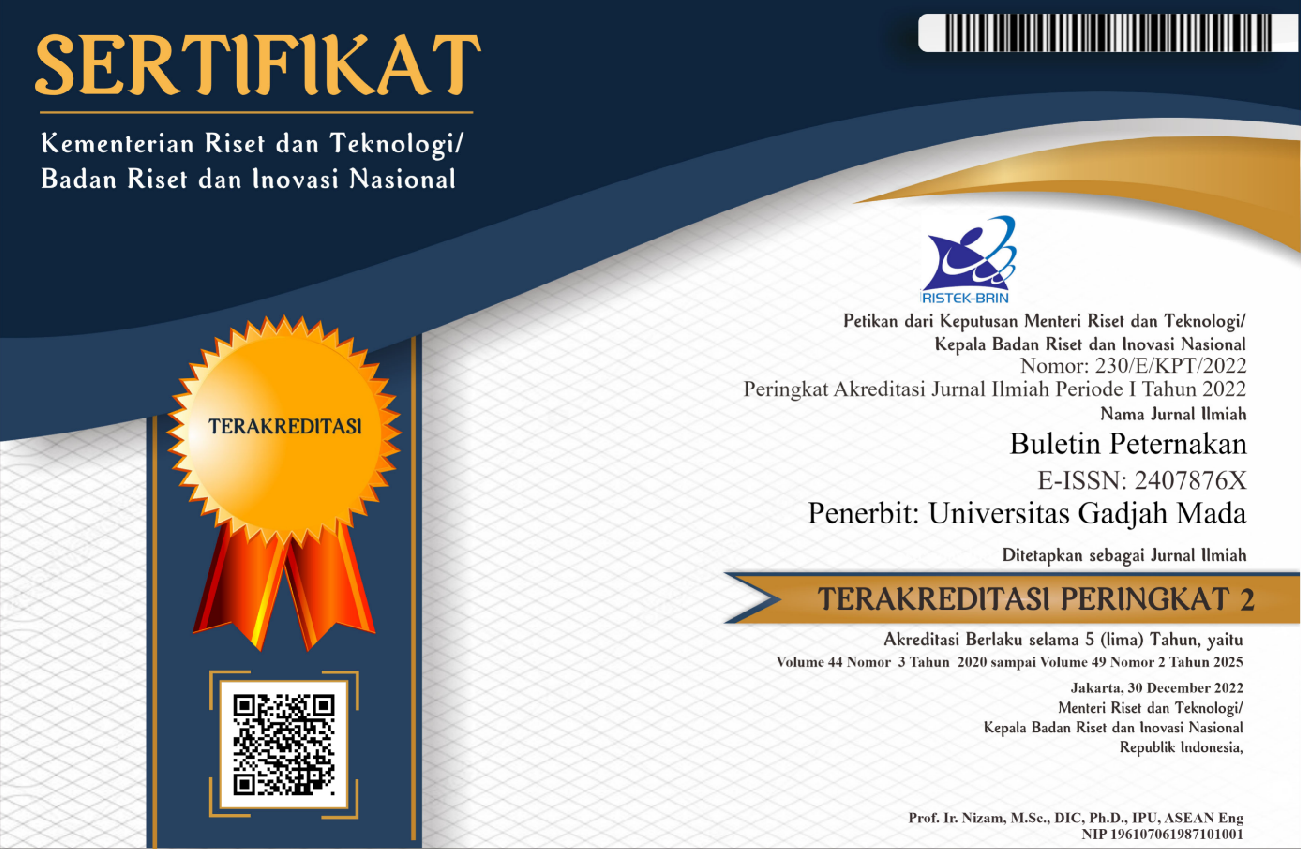Optimization of the Use of Farm Waste and Water Hyacinth for Earthworm (Lumbricus rubellus) Cultivation Media
Ulan Paluti Agustina(1), Agus Prasetya(2), Ambar Pertiwiningrum(3*)
(1) Master Program of Technology for Sustainable development, Universitas Gadjah Mada, Yogyakarta, 55281, Indonesia
(2) Departement of Chemical Engineering, Faculty of Engeneering, Universitas Gadjah Mada, Yogyakarta, 55281, Indonesia
(3) Department of Animal Products Technology, Faculty of Animal Science, Universitas Gadjah Mada, Yogyakarta, 55281, Indonesia
(*) Corresponding Author
Abstract
Keywords
Full Text:
PDFReferences
Aini, F. N. and D. K. Nengah 2013. The effect of water hyacinth (Eichhornia crassipes) addition on the growth of white oyster mushroom (Pleurotus ostreatus). Jurnal Sains dan Semi Pomits 2: 2337-3520.
AOAC. 2000. Official Methods of Analysis. 17th edn. Association of Official Analytical Chemists, EUA.
Apriliani, L. 2017. Influence of combination of coconut tree Sawdust and Manila grass (Zoysia matrella) on the growth and production of earthworm cocoon (Eudrilus eugeniae). Jurnal Prodi Biologi 6: 35-42.
Badruzzaman, D. Z., W. Juanda, and Y. A. Hayati. 2016. Study of the quality of castings in vermicomposting from the mixture of dairy-cow manure and rice straw. Jurnal Ilmu Ternak 16: 43-48.
Banu, J. R., I. T. Yeom, S. Esakkiraj, N. Kumar and S. Logakanthi. 2008. Biomanagement of sago-sludge using an earthworm, Eudrilus eugeniae. J. Environ. Biol. 9: 143-146.
Brata, B. 2008. The quality of castings of several species of earthworm at different rate of watering and liming. Jurnal Sain Peternakan Indonesia 3: 43-48.
Damayanti, V., O. Wiharyanto and S. Endro 2017. The effect of adding vegetable waste on the total organic and nitrogen content in vermicomposting rumen waste from animal slaughterhouse (RPH). Jurnal Teknik Lingkungan 6: 1-14.
Elidar, P. 2009. The role of earthworm Eisenia fetida and Lumbricus rubellus in consuming organic waste. A Thesis. Graduate School of IPB, Bogor.
Fernandez-Gomez, M. J., R. Nogales, H. Insam, E. Romero, and M. Goberna. 2010. Continous-feeding vermicomposting as a recycling management method to revalue tomato-fruit wastes from greenhouse crops. J. Waste Manage. 30: 2461-2468.
Gerbono and Siregar. 2005. Kerajinan Eceng Gondok. Kanisius, Yogyakarta.
Manurung, R. J., Yusfiati, and I. R. Dewi 2014. The growth of earthworm (Perionyx sp) on two media. Jurnal Online Mahasiswa FMIPA 1: 291-302.
Noviansyah, N. F. 2015. The effect of ratio of dairy-cow manure to cabbage waste (Brassica oleracea) in vermicomposting on earthworm biomass (Lumbricus rubellus). Students E-Journal 4: 1-9.
Palungkun, R. 2010. Building Earthworm (Lumbricus rubellus) farm successfully. Penebar Swadaya, Jakarta.
Pratiwi, I. G. A. P. 2013. Quality analysis of compost from rice-field waste with local micro-organism as decomposer. E-Journal Agroteknologi Tropika 2: 195-2013.
Rahmawati, E. and H. Welly 2016. Vermicomposting of garden waste using earthworm Eudrilus eugeneae and Eisenia fetida. Jurnal Teknik ITS 5: C33-C37.
Riswandi. 2014. Quality of water Hyacinth (Eichhornia crassipes) silage with the addition of bran and cassava powder. Jurnal Peternakan Sriwijaya 3: 1-6.
Sarinadira, A. and H. M. Bayu 2015. The effects of tofu liquid waste and chicken manure on the increase of wet weight of earthworm (Lumbricus rubellus). Jurnal Pendidikan Hayati 1: 20-25.
Sittadewi, E. H. 2007. The processing of organic water Hyacinth into growing media to support organic farming. Jurnal Teknik Lingkungan 8: 229-234.
Singh, D. and S. Suthar. 2012. Vermicomposting of herbal pharmaceutical industry waste: earthworm growth, plant-available nutrients and microbial quality of end material. Bioresource Tech. 112: 179-185.
Suthar, S. and S. Gairola. 2014. Nurient recovery from urban forest leaf litter waste solids using Eisenia fetida. J. Ecol. Eng. 71: 660-666.
Tistiana, H. 2011. Results of Laboratory Analysis. Department of Animal Nutrition and Feed, Faculty of Animal Husbandry, Brawijaya University, Malang.
Wahyuni, S. 2008. Biogas. Penebar Swadaya, Jakarta.
Wangliang, L., C. Lu, Y. Zhang, and Y. W. Tong. 2017. Integration of high-solid digestion and gasification to dispose horticultural waste and chicken manure. J. Cleaner Prod. 164: 146-152.
Yonathan, A., R. P. Avianda and P. Bambang 2012. Production of biogas and water Hyacinth (Eicchornia Crassipes): the study of consistency and pH on biogas produced. Jurnal Teknologi Kimia dan Industri 1: 412-416.
Yunitasari, R., T. S. H. Alexander, and D. S. Liliya. 2015. The effect of feeding organic waste from canteen on the growth of earthworm (Lumbricus rubellus) with leaf litter from around Brawijiaya University Campus as the media. Jurnal Sumberdaya Alam dan Lingkungan 2: 27-31.
Article Metrics
Refbacks
- There are currently no refbacks.

This work is licensed under a Creative Commons Attribution-ShareAlike 4.0 International License.
Buletin Peternakan (Bulletin of Animal Science) Indexed by:

This work is licensed under a Creative Commons Attribution-ShareAlike 4.0 International License.










